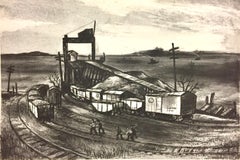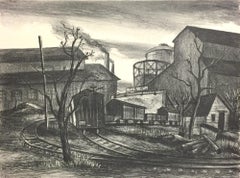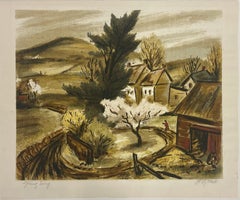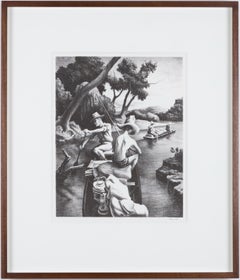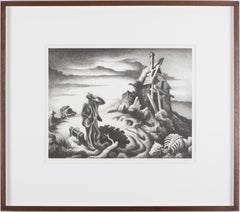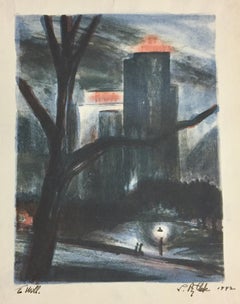Leonard Pytlak Landscape Prints
to
3
1
Overall Width
to
Overall Height
to
6
180
169
146
131
4
3
3
1
3
1
1
1
3
1
4
Artist: Leonard Pytlak
Leonard Pytlak, The Bin (Industrial Landscape)
By Leonard Pytlak
Located in New York, NY
This lithograph is signed and titled in pencil.
Category
1930s Ashcan School Leonard Pytlak Landscape Prints
Materials
Lithograph
Leonard Pytlak, Side Street (New York City)
By Leonard Pytlak
Located in New York, NY
This lithograph is signed in pencil.
Leonard Pytlak lived on the East Side of Manhattan and this image recalls the 59th Street Bridge (also known as the Queensboro Bridge and the Ed Koch Queensboro Bridge), completed in 1909. It goes from Manhattan to Queens and passes over Roosevelt Island...
Category
1930s Ashcan School Leonard Pytlak Landscape Prints
Materials
Lithograph
Leonard Pytlak, (Industrial Landscape, New York City)
By Leonard Pytlak
Located in New York, NY
This lithograph is signed and number in pencil. It is numbered 18/18 indicating there were 18 impressions of this subject printed.
Category
1930s Ashcan School Leonard Pytlak Landscape Prints
Materials
Lithograph
SPRING SONG
By Leonard Pytlak
Located in Portland, ME
Pytlak, Leonard. SPRING SONG. Screenprint in colors, not dated. Edition size not known. Titles and Signed in pencil. 14 1/2 x 17 3/4 inches (sheet). In excellent condition.
Category
Mid-20th Century Leonard Pytlak Landscape Prints
Materials
Screen
Related Items
Down the River
By Thomas Hart Benton
Located in London, GB
In this sentimental work from 1939, Benton expresses his admiration for the rural lifestyle of the Midwest. He highlights the connection between man and the land by depicting two fig...
Category
1930s American Modern Leonard Pytlak Landscape Prints
Materials
Lithograph
Prodigal Son
By Thomas Hart Benton
Located in London, GB
A man raises his hand to his chin, his neck tilted and face turned to look at a dilapidated farmhouse, barely held together by planks of wood and exposed to the elements. Behind him ...
Category
1930s American Modern Leonard Pytlak Landscape Prints
Materials
Lithograph
Canaletto
By Patrick Hughes
Located in London, GB
A hand painted three dimensional, Reverspective print, inspired by Venice. Produced in 2024. This print comes housed in a bespoke perspex display case. A limited edition of 75.
Hand...
Category
2010s Contemporary Leonard Pytlak Landscape Prints
Materials
Lithograph, Offset
Bill Schenck, Last Horizon, Serigraph
By Bill Schenck
Located in Phoenix, AZ
SHIPPING CHARGES INCLUDE SHIPPING, PACKAGING & **INSURANCE**
Last Horizon, 1991
Bill Schenck
Serigraph, Printers Proof
Size: 27.75 x 29.75 inches
UNFRAMED
SHIPPING CHARGES INCLUDE...
Category
1990s Contemporary Leonard Pytlak Landscape Prints
Materials
Screen
Eyvind Earle 'Ocean Splash' Signed, Limited Edition Print
By Eyvind Earle
Located in San Rafael, CA
Eyvind Earle (1916-2000)
Ocean Splash, 1991
Serigraph in colors on wove paper
Edition 119/150
Signed lower right
With publishers/printers stamp to lower left margin
Image: 36in H x ...
Category
1990s Contemporary Leonard Pytlak Landscape Prints
Materials
Screen
$2,500
H 44 in W 22 in D 0.02 in
Thomas Moran Chromolithograph Print 1893 of the Grand Canyon
By Thomas Moran
Located in Rome, IT
Created by Gustav Buek from an original oil painting made in 1892 by Thomas Moran. The painting is today owned by the Philadelphia Museum of Art in Philadelphia, Pennsylvania. Both w...
Category
Late 19th Century Leonard Pytlak Landscape Prints
Materials
Lithograph
$11,361 Sale Price
20% Off
H 37.41 in W 54.34 in D 3.15 in
"Waco" Serigraph by Billy Schenck, 1981
By Billy Schenck
Located in Los Angeles, CA
Bill Schenck
Waco
Serigraph 7/58
1981
Hand signed, date and numbered by Schenck in pencil.
25.75 inches H. x 25 inches W.
'Waco' is classic early example...
Category
Late 20th Century Pop Art Leonard Pytlak Landscape Prints
Materials
Screen
Reds and Black August 20, 2020
By Donald Sultan
Located in Calabasas, CA
Artist: Donald Sultan
Title: Reds and Black August 20, 2020
Year: 2020
Medium: Silkscreen with enamel inks, flocking, and tarlike texture on Rising 4-ply Museum Board
Sheet: 44 x 84...
Category
2010s Contemporary Leonard Pytlak Landscape Prints
Materials
Screen
Wave Of Distress Shepard Fairey Print Obey Giant "World Water Day" Urban Pop Art
By Shepard Fairey
Located in Draper, UT
"World Water Day is Monday and is a fitting day to precede the release of these Wave of Distress prints. World Water Day not only focuses attention on the water crisis and drinking w...
Category
2010s Street Art Leonard Pytlak Landscape Prints
Materials
Screen
The Tennis Court - Mandela, South African President, Signed, Robben Island, sport
By Nelson Mandela
Located in Knowle Lane, Cranleigh
Nelson Mandela, The Tennis Court, Signed Limited Edition Lithograph
Many people are unaware that Nelson Mandela turned his hand to art in his 80's as a way of leaving a legacy for hi...
Category
Early 2000s Contemporary Leonard Pytlak Landscape Prints
Materials
Lithograph
$10,060
H 15.75 in W 20.08 in D 1.58 in
The Lighthouse - Mandela, Former South African President, Signed, Robben Island
By Nelson Mandela
Located in Knowle Lane, Cranleigh
Nelson Mandela, The Lighthouse, Signed Limited Edition Lithograph
Many people are unaware that Nelson Mandela turned his hand to art in his 80's as a way of leaving a legacy for his family. He spent time with an art tutor and learnt to draw. In 2002, when creating the The Lighthouse print...
Category
Early 2000s Contemporary Leonard Pytlak Landscape Prints
Materials
Lithograph
$12,072
H 19.69 in W 22.05 in D 1.58 in
The Irish Fair
By George Wesley Bellows
Located in Fairlawn, OH
Irish Fair
Lithograph, 1923
Signed and numbered in pencil by the artist (see photo)
Titled "Irish Fair" by the artist in pencil
Edition: 84
Housed in an archival frame with acid free matting (see photo)
Provenance:
Estate of the artist, Bellows Family Trust
H.V. Allison & Company (label)
Private Collection, Columbus
References And Exhibitions:
Reference: Mason 153
Note: An illustration commissioned by The Century Company for Don Byrne's novel The Wind Bloweth
Image: 18 7/8 x 21 3/8"
Frame: 29 1/2 x 30 1/2"
“Eleven on a hot July morning, and the little town...
Category
1920s Ashcan School Leonard Pytlak Landscape Prints
Materials
Lithograph
Previously Available Items
RCA Building
By Leonard Pytlak
Located in New York, NY
Leonard Pytlak was based in New York City and was active on New Deal printmaking projects. He made lithographs and serigraphs. This color lithograph, signed and dated in ink, perfectly captures a moody, misty New York night.
The RCA building is 30 Rockefeller Plaza -- seen here from the north, Central Park. It is an art deco marvel designed by Raymond Hood and completed in 1933. It was already a NYC...
Category
Mid-20th Century Ashcan School Leonard Pytlak Landscape Prints
Materials
Lithograph
Leonard Pytlak landscape prints for sale on 1stDibs.
Find a wide variety of authentic Leonard Pytlak landscape prints available for sale on 1stDibs. You can also browse by medium to find art by Leonard Pytlak in lithograph and more. Not every interior allows for large Leonard Pytlak landscape prints, so small editions measuring 13 inches across are available. Customers who are interested in this artist might also find the work of Fred Nagler, and John Sloan. Leonard Pytlak landscape prints prices can differ depending upon medium, time period and other attributes. On 1stDibs, the price for these items starts at $500 and tops out at $1,200, while the average work can sell for $900.
